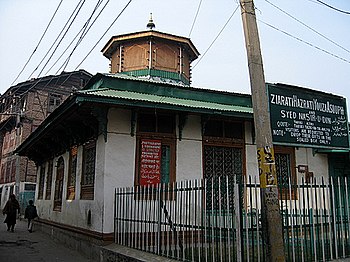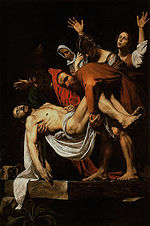| Revision as of 13:38, 24 January 2013 editSuzanneOlsson (talk | contribs)Extended confirmed users818 editsNo edit summary← Previous edit | Revision as of 13:42, 24 January 2013 edit undoSuzanneOlsson (talk | contribs)Extended confirmed users818 edits →External linksNext edit → | ||
| Line 42: | Line 42: | ||
| * | * | ||
| * | * | ||
| * Suzanne Olsson's website examines the theory of Jesus in India, recommends additional reading on the topic. | |||
| {{coord missing|Jammu and Kashmir}} | {{coord missing|Jammu and Kashmir}} | ||
Revision as of 13:42, 24 January 2013

| Part of a series on |
| Death and Resurrection of Jesus |
|---|
 |
| Passion |
| Resurrection |
| Holy Week |
| Significance |
| Visions of Jesus |
| Empty tomb theories |
| Related |
|
Portals: |
Roza Bal is the name of a shrine located in the Khanyaar quarter of the city of Srinagar in Kashmir (GPS: 34.085005,74.820196), venerated by some Muslims, Hindus and Buddhists. Some people identify the sage buried there with one Yuz Asaf[1] that is Jesus of Nazareth, whom they allege to have arrived in Kashmir after surviving his crucifixion. Several authors have held the view that Jesus had travelled to the Indian subcontinent including Mirza Ghulam Ahmad and the Russian traveler Nicolas Notovitch. The tomb has gained increasing popularity as the possible tomb of Jesus. Historically, however, the Holy Sepulchre is considered by some Christians as the tomb of Christ.
The tomb itself consists of a low rectangular building on a raised platform, surrounded by railings at the front. It has three arches at the front, where entry can be had, and four arches at the side. Inside is a rock carving that is said to show feet bearing crucifixion wounds. The body is buried according to the Jewish tradition of directions and not according to the Islamic tradition. However, the building also houses the burial tomb of a local Muslim saint, Mir Sayyid Naseeruddin, who was buried in line with Islamic directions.
The tomb was previously maintained by local descendants of the buried sage. It is currently maintained by a Board of Directors consisting of Sunni Muslims. Sahibzada Basharat Saleem, a former caretaker (now deceased), claimed to hold genealogical tables that showed he was a direct descendant of the buried sage.
In 2003, The BBC first televised a documentary that included a section on the story of Yuz Asaf titled "Did Jesus Die?"
In 2010, the Govt. of India's Film Division produced a comprehensive documentary film on the subject, titled "The Rozabal Shrine of Srinagar." It was written & directed by Yashendra.
See also
References
| This article includes a list of general references, but it lacks sufficient corresponding inline citations. Please help to improve this article by introducing more precise citations. (April 2009) (Learn how and when to remove this message) |
-
{{cite book}}: Empty citation (help) - Miller, Sam (27 March 2010). "Tourists flock to 'Jesus's tomb' in Kashmir". BBC. Retrieved 27 November 2010.
- ^ "Did Jesus die?". BBC. Retrieved 2009-05-25.
{{cite web}}: Cite has empty unknown parameter:|coauthors=(help) - James Polster: Mystery of the Martyr's Tomb. Yahoo! News, May 15, 2006
Further reading
- A search for the Historical Jesus by Prof. Fida Hassnain. Gill & Macmillian, Ireland
- The Fifth Gospel by Fida Hassnain. Bluedolphin Publishing.USA
- Jesus in Kashmir, The Lost Tomb by Suzanne Olsson, Gulshan Publishers, Srinagar, India
External links
- The Tomb of Jesus Website (site examines theory of Jesus in India. Includes videos and photos of Roza Bal)
- BBC Tourists flock to 'Jesus's tomb' in Kashmir
- Jesus in Ahmadiyya Muslim Community
- Suzanne Olsson's website examines the theory of Jesus in India, recommends additional reading on the topic.
Categories: